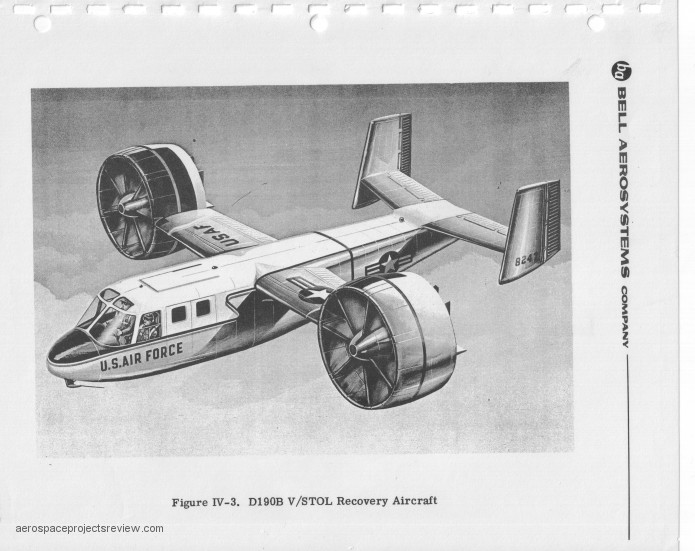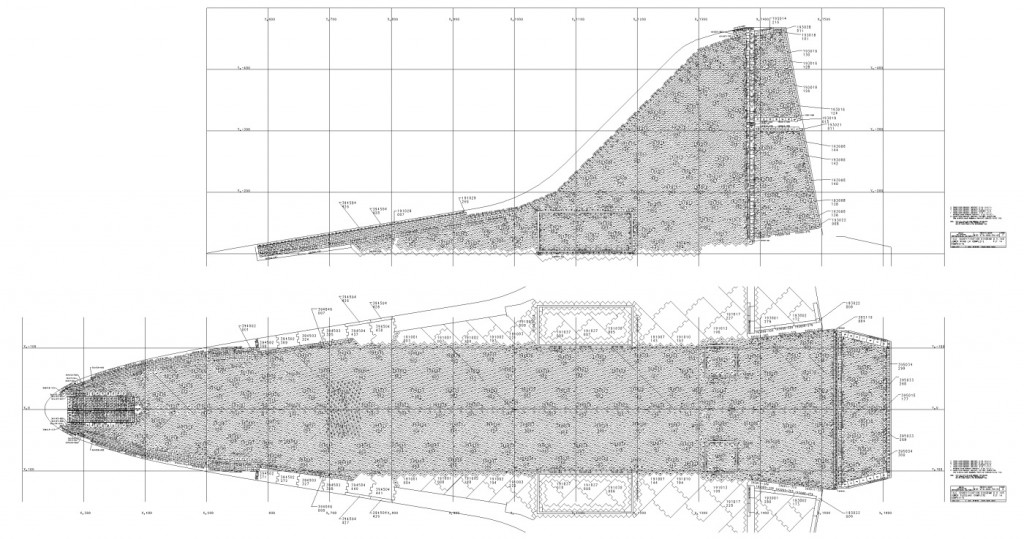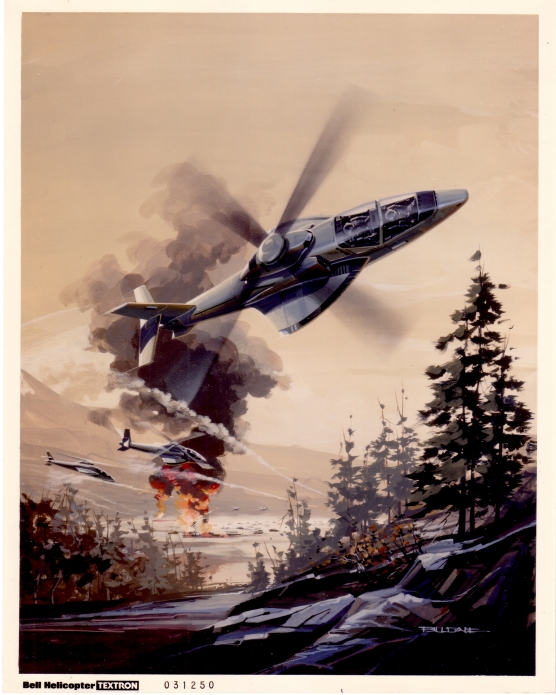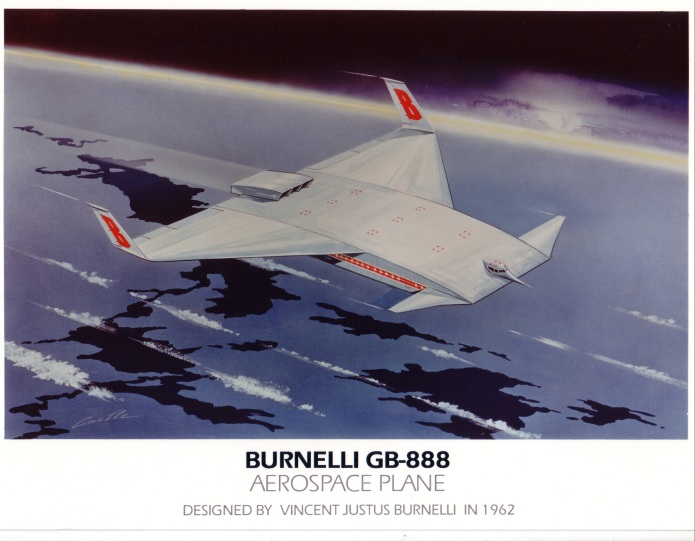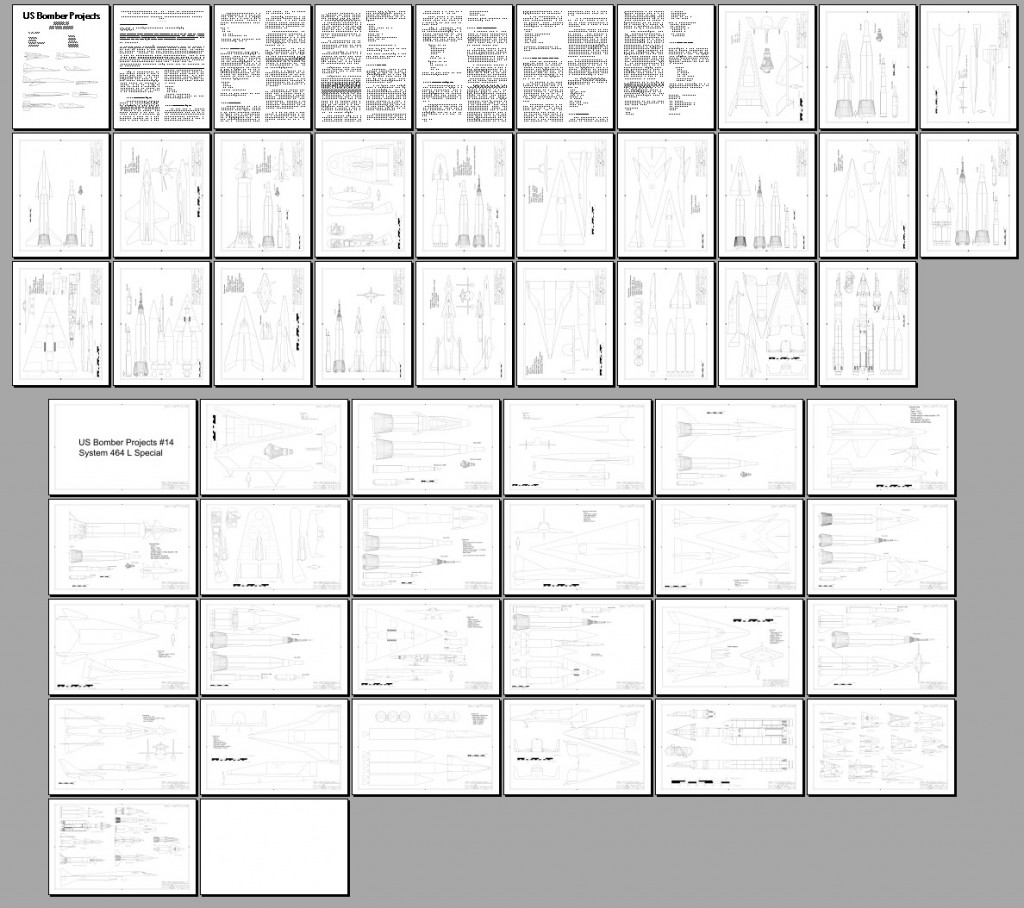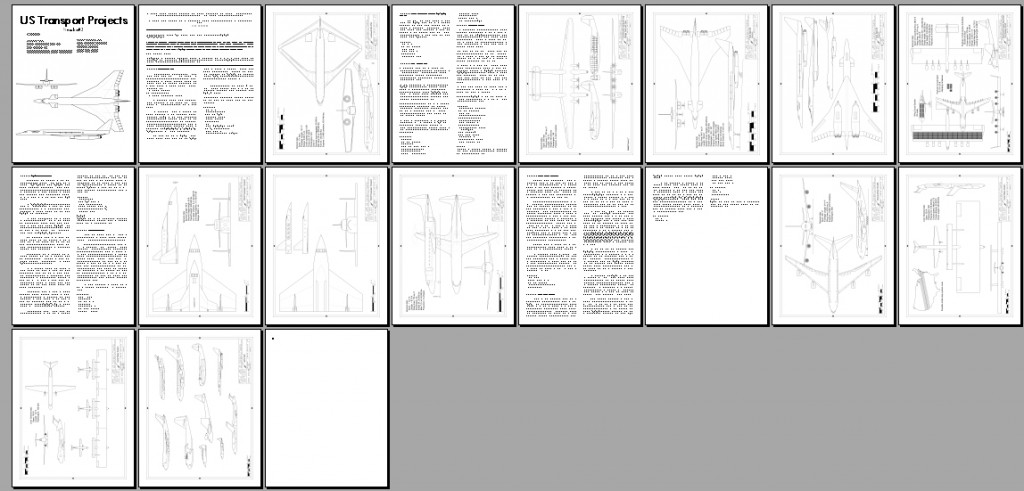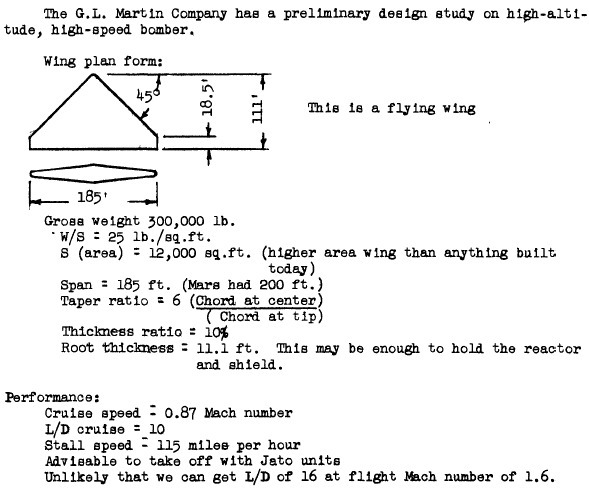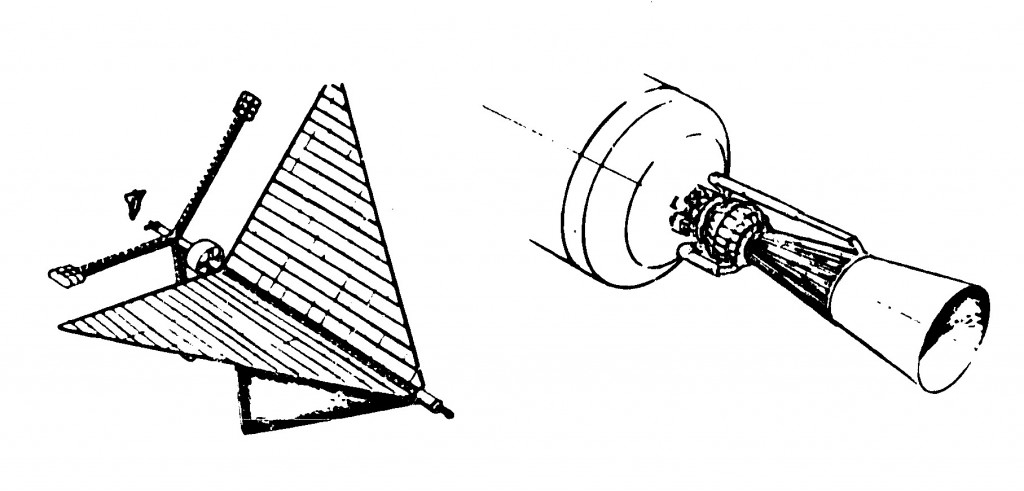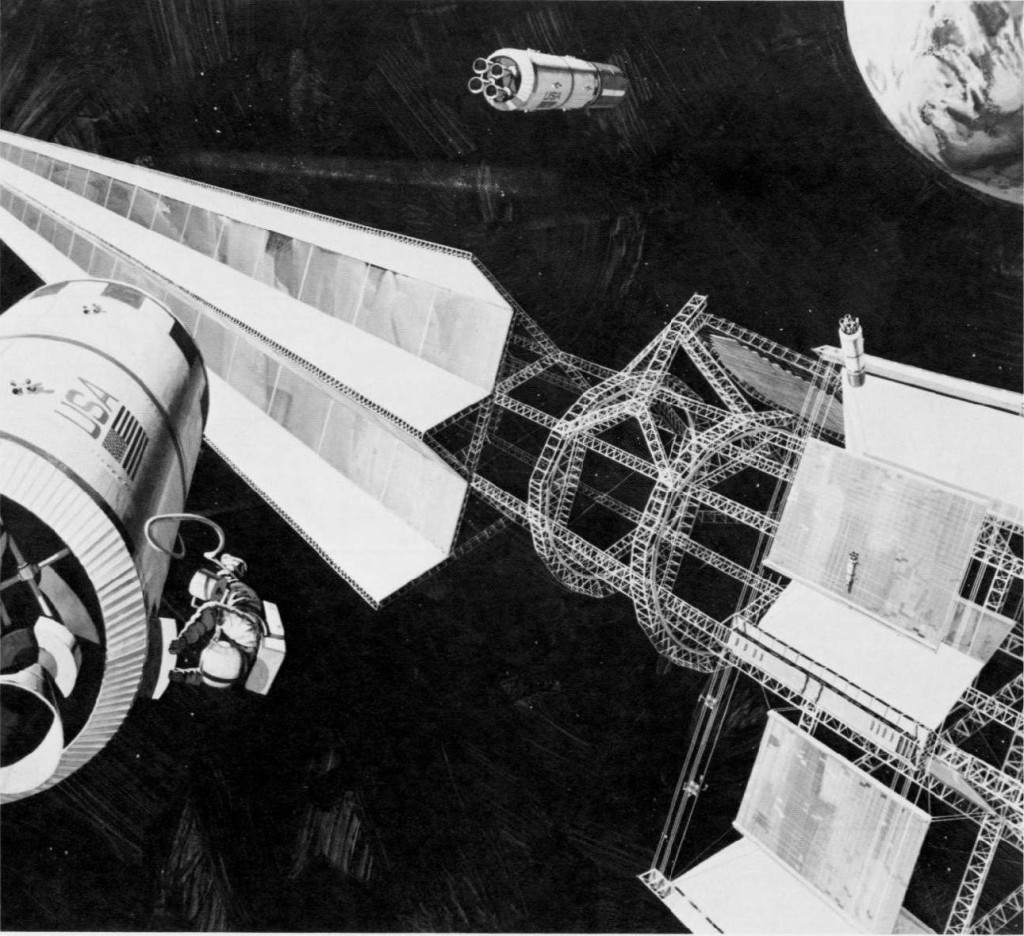Just added five more issues to Amazon for $2.99 each. These are Kindle-fied versions of the issues otherwise available as PDFs here.
Below is an artists impression of the Bell D190B, a tilt-duct VTOL derived in part from the X-22. The D190 series, dating from the early 1960’s, was for a more-or-less common airframe design that could carry out a number of missions. Interestingly, variants of this design were considered for “parasite” roles. The aircraft could hard-dock to the underside of a C-130; the larger transport aircraft could then haul the smaller VTOL around the world, where it could serve as a rescue plane (note the rectangular hatch on the top of the fuselage). Another idea was for the small VTOL to serve as a crew or passenger transfer system for EC-135J (707 derivatives) flying command posts, including transporting VIPs (read: politicians) away from nuclear strikes to orbiting escape planes.
Sadly, while I’ve found many bits and pieces on this over the years, I’ve yet to come across good design data. If anyone has anything, I’d love to see it.
I have made the full-rez version of this scan available at the APR Patreon for $4-and-up patrons. It is in the APR Patreon “Extras” Dropbox, in the 2015-04 folder.
I’m currently working on a series of Shuttle Orbiter tile “maps” to massage them into a form where they’d look good as cyanotype blueprints. Two are shown below; what I have on hand are about a dozen, covering every surface of the Orbiter. The centerline diagram is sized for 40 inches wide by 160 inches long; this is *way* beyond reasonable size for cyanotyping. But at 18 inches wide, it’d be 72 inches long… just about what I can handle.
Another option might be to stitch the separate views together, rather than two wings and a centerline. Printed out B&W on paper, it’d be pretty durned impressive.
Earlier this month I posted small sketches of a remarkable 1981 Boeing concept for a spacecraft meant to haul 1,200 passengers to the asteroids. The source the illustrations came from didn’t have much design data, so I had hopes that the references the document called out would. There were two references that seems relevant; one was publicly available, and didn’t have anything on this; the other was not publicly available, so I made a Freedom of Information Act request for it. And a CD-ROM with PDF files arrived in my mailbox Monday with the response. Sad to say, while it had some interesting things on it, the document does *not* make reference to this craft.
So, for the moment research on this is kinda stymied. It may well be that this design was just a minor notion, produced specifically for the 1981 Boeing study with nothing more detailed to back it up. Or it may be that it was based on prior unpublished Boeing internal work. or it may have come from a prior classified study that could not be readily referenced. In any event, unless something unlikely occurs, that would seem to be that. I am going to make a few attempts at researching this through some slim back channels, but I hold out minimal hope.
A piece of Bell Helicopter artwork depicting their design for the LHX competition, what became the RAH-66 Comanche. Note that this design featured unusual curved, swept sponsons and a NOTAR (no tail rotor) tail.
The full resolution version of this scan has been made available for $4 patrons at the APR Patreon.
Vincent Burnelli was an aircraft designer who specialized in lifting-fuselage aircraft… instead of a cylindrical tube, his fuselages were fat unswept wing cross-sections. The thinking was that this would reduce drag and increase lift and make the vehicles more structurally sound in the event of a crash; while in some cases testing did show some occasional advantages, on the whole these designs did not provide much if any aerodynamic advantage; and once aircraft started flying high enough to require pressurization, the non-circular cross section made pressurization difficult to achieve cost effectively. Sadly, any advantages these designs may have had have been overshadowed by the largely unhinged conspiracy theories that have sprung up around why they haven’t been adopted.
One of the last of Burnellis designs (from about 1962) was the “GB-888,” a supersonic jetliner of unusual configuration. Artwork reproduced below seems to date from the 1980s; here the SST has been relabeled an “aerospaceplane.” The idea, apparently, was to ride the coattails of the X-30 National Aero Space Plane, which had a *vaguely* similar lifting fuselage configuration. As drawn, of course, the GB-888 would make a terrible ASP… the windows on the sides would be melt nicely on re-entry; the sharp edges would concentrate aerothermal heating loads to a fantastic degree; and putting then engines on the top surface would do a fantastic job of getting them out of the airflow, assuring that the engines would not perform very well at all. Still, it’s interesting art.
I have made the high-rez of this illustration available for $4-level patrons at the APR Patreon.
Now available… two new additions to the US Aerospace Projects series.
US Bomber Projects #14: System 464L Special
USBP#14 brings together the competitors to Weapon System 464L, the first major effort in the Dyna Soar program. These designs were previously shown individually in prior issues of USBP; here they are brought together, with some updates, as well as a few extra diagrams and a section of diagrams formatted for 11X17 printing. This issue includes info and diagrams of the Lockheed, Republic, General Dynamics, McDonnell, Boeing, Douglas, Northrop, North American and Martin-Bell entries as well as their various booster systems. Also included are detailed diagrams of the ultimate Dyna Soar design, the 2050E.
USBP#14 can be purchased for downloading for the low, low price of $6.25.
Also available:US Transport Projects #03.
Included in this issue:
- Lockheed “Environmentally Responsible Aviation” box-wing jetliner
- Martin Commercial Twin-Hull concept from 1942
- North American Aviation NAC-60 SST competitor
- McDonnell-Douglas Cargo Spanloader
- Boeing Model 763-058 “New Large Airplane”
- BoMi Passenger Transport Rocket
- Lockheed L-152-1 early jet transport with unusual inlets
- Aerial Relay System: for when crazy is preferred
USTP #03 can be purchased for download for only $4.25:
More than sixty years ago, the US government and various aeronautical contractors began examining the application of atomic energy to powering aircraft. A mountain of documentation was produced, much of which has been lost, forgotten or is still locked behind classification. But some things come out from time to time that provide tantalizing hints as to what the designers of the time were thinking.
One such document is a short memo from June, 1948, describing a lecture given to unnamed staff by one William van Zelm of the Glenn L. Martin Corporation, describing aspects of aircraft design for atomic flight. Being simply a description of the lecture, the details are lean, but a sketch was included:
The design, crude and simply reproduced as it is, looks very reminiscent of a number of “stealth” aircraft that have been designed over the years including the A-12 Avenger II and the General Dynamics “Sneaky Pete” concept. This one, of course, was nuclear powered and apparently capable of supersonic speeds. It would be interesting to find more about this particular design.
The memo can be downloaded HERE.
Much more aerospace stuff is available via the APR Patreon.
Every now and then you stumble across something that provides tantalizing yet nonchalant hints to something amazing. Recently this occurred while perusing a Boeing report on closed life support systems for spacecraft. One concept mentioned and minimally described was a previous 1981 study of a spacecraft meant to transport crew to the asteroid belt for the purpose of mining asteroids for their resources. Just the basic concept was fairly amazing on its own, especially all the way back in 1981. Second: the propulsion system was vaguely described as a nuclear fusion system. Third: well, here’s the disappointingly small diagram that was included for illustration purposes. See if you can see what makes the design especially interesting…
What can be seen: three arms that rotate for artificial gravity; three vast radiator fins and a relatively tiny fusion engine in the tail. But what makes the design amazing: just in front of the spacecraft is a Space Shuttle Orbiter, giving a sense of scale to the vehicle. It’s *vast.* And it would have to be… the cargo transported to the asteroid was 150 metric tons. Plus the passengers, all 1,250 of them. All ONE THOUSAND TWO HUNDRED AND FIFTY of them.
The vehicle massed 10,000 tons; the powerplant (two 6 GW fusion reactors, spitting out 4.8 GW of thrust power, 2.8 GW of heat needing radiating and 4.4 GW of high energy neutron) massed 2000 tons; 4000 tons of hydrogen fuel; and 4000 tons of spacecraft/payload/passengers. The vehicle would boost for 11 days, coast for 226 days and brake for 13 days to rendezvous.
That, sadly, is all that’s available in the report I have. A FOIA request has been made for the reference that *seems* like might describe this further.
I hope to be able to define this vehicle further. As it is I can only guesstimate sizes; the habitation modules at the ends of the arms appear to be repurposed Shuttle External Tanks. But even nine of them would seem to be kinda cramped for 1250 people for two-thirds of a year… nearly 140 passengers per tank.
Another piece of artwork depicting the construction of a solar power satellite. This design features a “trough” design. Instead of a vast flat plain covered in PV arrays, this design had a central strip of PV cells between two walls of very reflective and very lightweight mylar (or a similar reflective foil). Thus the same total amount of sunlight would be directed to PV cells. Since PV clls generally work slightly better at higher illumination levels, in theory this type of PV array should generate more power for the same frontal area.
Shown slightly to the right of center is the aimable microwave emitter used to beam the energy to a receiving station on Earth.
